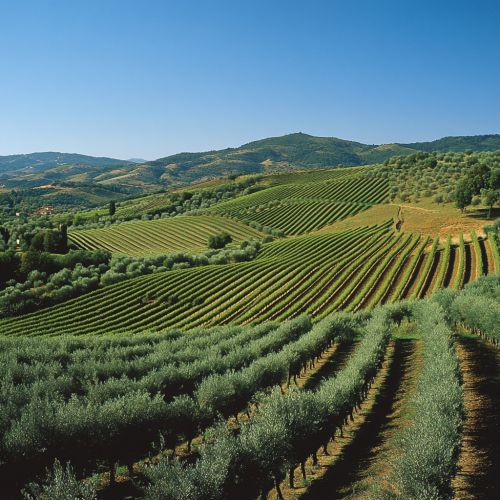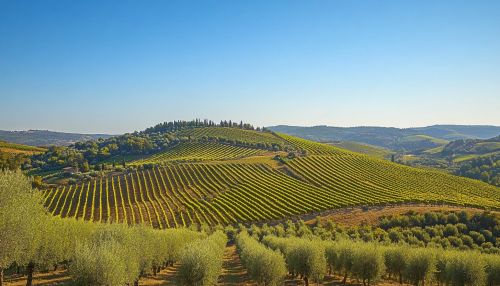Tuscany
Geography and Climate
Tuscany, or Toscana in Italian, is a region in central Italy renowned for its picturesque landscapes, rich artistic legacy, and significant influence on high culture. The region is bordered by Liguria to the northwest, Emilia-Romagna to the north, Marche to the northeast, Umbria to the east and southeast, Lazio to the south, and the Tyrrhenian Sea to the west. Tuscany covers an area of approximately 22,993 square kilometers and is characterized by its diverse topography, which includes the rugged Apennine Mountains, rolling hills, fertile plains, and a long coastline.
The climate in Tuscany varies from a Mediterranean climate along the coast to a more continental climate in the interior. Coastal areas experience mild, wet winters and hot, dry summers, while the inland areas, particularly those at higher elevations, can have colder winters with occasional snowfall.


History
Tuscany has a rich history that dates back to the Etruscan civilization, which flourished in the region from the 8th to the 3rd century BCE. The Etruscans were known for their advanced culture, art, and architecture, and they played a significant role in the development of early Roman society. The region was later conquered by the Romans, who established the province of Etruria.
During the Middle Ages, Tuscany became a center of commerce and culture, with cities like Florence, Siena, and Pisa emerging as powerful city-states. The region was a major player in the Italian Renaissance, a period of great cultural and artistic achievement that began in the 14th century. Florence, in particular, was a hub of Renaissance art and thought, home to figures such as Leonardo da Vinci, Michelangelo, and Dante Alighieri.
In the 19th century, Tuscany was incorporated into the newly unified Kingdom of Italy. Today, it remains a vital part of Italian culture and economy, known for its contributions to art, cuisine, and wine.
Economy
Tuscany's economy is diverse, with agriculture, industry, and tourism being the primary sectors. The region is famous for its wine production, particularly the Chianti variety, which is produced in the central part of Tuscany. Other notable wines include Brunello di Montalcino and Vino Nobile di Montepulciano. Olive oil is another significant agricultural product, with Tuscan olive oil being highly prized for its quality.
The industrial sector in Tuscany is varied, with a focus on textiles, leather goods, and marble. The town of Carrara is renowned for its high-quality marble, which has been used in sculptures and buildings since Roman times.
Tourism is a major economic driver, with millions of visitors drawn to the region's art, history, and natural beauty. Key attractions include the historic centers of Florence, Pisa, and Siena, as well as the scenic countryside of the Val d'Orcia and the coastal areas of the Maremma.
Culture and Art
Tuscany has a rich cultural heritage, deeply rooted in the arts. The region is home to numerous museums, galleries, and historical sites. Florence, the capital of Tuscany, is often referred to as the "cradle of the Renaissance" and houses some of the world's most famous art collections, including the Uffizi Gallery and the Palazzo Pitti.
The region's architecture is equally renowned, with landmarks such as the Florence Cathedral, the Leaning Tower of Pisa, and the Siena Cathedral drawing visitors from around the world. Tuscan architecture is characterized by its use of local materials, such as sandstone and marble, and its harmonious integration with the surrounding landscape.
Tuscany is also known for its contributions to literature, with figures like Dante, Petrarch, and Boccaccio having left a lasting impact on Italian and world literature.
Cuisine
Tuscan cuisine is celebrated for its simplicity and focus on high-quality ingredients. It is heavily influenced by the region's agricultural products, including olive oil, wine, and fresh produce. Traditional dishes include ribollita, a hearty vegetable soup; bistecca alla fiorentina, a thick-cut T-bone steak; and panzanella, a bread and tomato salad.
The region is also known for its variety of cured meats, such as prosciutto Toscano and finocchiona, a fennel-flavored salami. Tuscan bread, made without salt, is a staple of the local diet and is often used in dishes like pappa al pomodoro, a tomato and bread soup.
Language and Dialects
The primary language spoken in Tuscany is Italian, but the region is known for its distinctive Tuscan dialect, which has had a significant influence on the development of the Italian language. The Tuscan dialect is considered the basis for standard Italian, largely due to the works of Dante, Petrarch, and Boccaccio, who wrote in the vernacular.
In addition to Italian, there are several regional dialects and languages spoken in Tuscany, including Corsican, which is spoken on the island of Elba, and Gallo-Italic dialects in the Lunigiana area.
Demographics
Tuscany has a population of approximately 3.7 million people, with the majority residing in urban areas. Florence is the largest city and serves as the administrative and cultural capital of the region. Other major cities include Prato, known for its textile industry; Livorno, a significant port city; and Arezzo, famous for its medieval architecture and annual jousting festival.
The region has a relatively high standard of living, with a strong emphasis on education and healthcare. Tuscany is home to several prestigious universities, including the University of Florence and the University of Pisa, which attract students from around the world.
Natural Environment and Biodiversity
Tuscany is renowned for its diverse natural landscapes, which include the Apennine Mountains, the rolling hills of the Chianti region, and the coastal areas along the Tyrrhenian Sea. The region is home to several national parks and protected areas, such as the Parco Nazionale delle Foreste Casentinesi and the Maremma Regional Park, which support a wide range of flora and fauna.
The Tuscan Archipelago, which includes the islands of Elba, Giglio, and Capraia, is a significant area of biodiversity, with unique ecosystems and endemic species. The region's varied habitats support a rich array of wildlife, including deer, wild boar, and numerous bird species.
